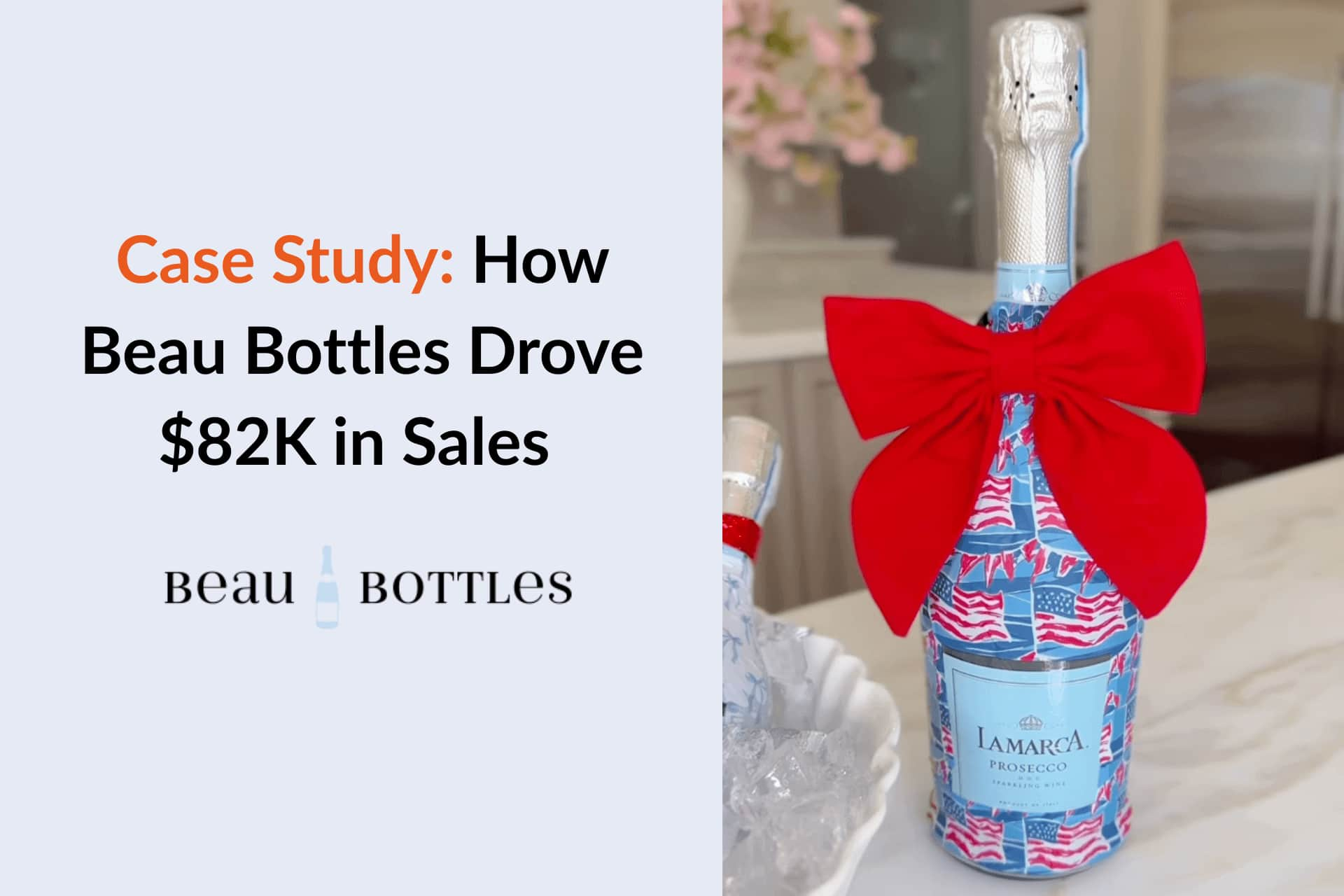





Choosing the right influencer marketing platform is key for scaling campaigns without wasting budget. While Insense is well-known for sourcing UGC and connecting with creators on TikTok and Instagram, many users are seeking alternatives. Common complaints include limited reporting tools, lack of collaboration features, and a complex onboarding process.
With the influencer marketing industry expected to hit $33 billion in 2025, picking the right platform is more important than ever—especially for DTC brands. In this article, we break down 10 of the top Insense alternatives based on real user feedback, features, and pricing.
Here are the top 10 Insense alternatives we’ll cover in detail:
While Insense offers a great way to sourcing UGC and connecting with creators on TikTok and Instagram, there are several limitations that may push some brands to consider other platforms:
While Insense facilitates access to a broad pool of creators, its compensation model can be restrictive. Campaigns often feature low fixed fees that may not align with the scope of work or usage rights requested, making it difficult to support fair compensation practices—especially for ongoing or high-effort collaborations.
Insense is primarily focused on short-form content platforms like TikTok and Instagram. Brands seeking to activate creators across other channels—such as YouTube, Pinterest, or blogs—may find the discovery options and integrations lacking in versatility.
The platform has been noted for occasionally presenting campaigns with unclear deliverable expectations or payment terms. This can lead to confusion around whether a collaboration is paid, gifted, or performance-based, ultimately impacting trust and campaign satisfaction on both sides.
Although Insense offers standard metrics and campaign tracking, its reporting tools fall short compared to more comprehensive influencer marketing platforms. Marketers looking for detailed performance insights, ROI tracking, and multi-campaign reporting may require a more robust analytics suite.
Our comparison focuses on several key aspects:
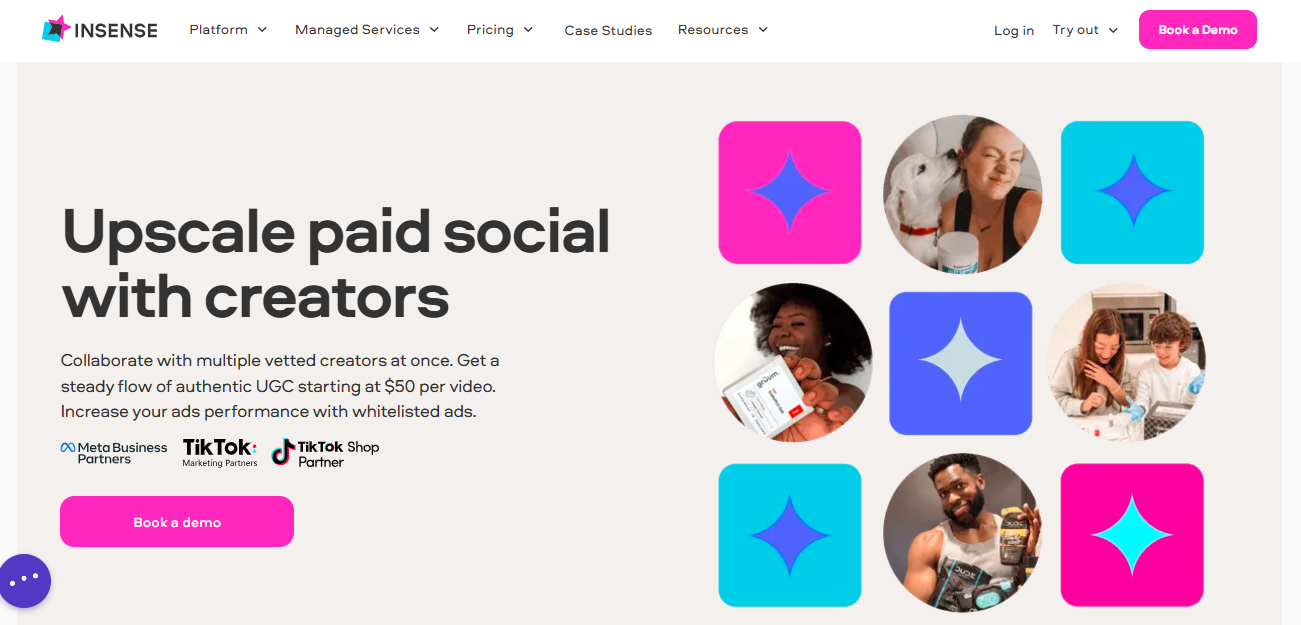
Best For: Insense is ideal for eCommerce and DTC brands on Shopify or Amazon looking to scale UGC production and influencer campaigns with flexibility and speed, especially across TikTok.
Platform Coverage: Insense supports campaigns on Instagram, TikTok, and TikTok Shop, with direct API integrations with Meta and TikTok. This enables verified performance data and automated campaign support across short-form video and social platforms. While YouTube is not directly supported, brands can repurpose UGC across any channel.
Pricing & Commitment: Insense offers a Brand Plan at $1,500 USD for 3 months (~$500/month), billed quarterly. The plan includes two user seats, full onboarding, and live support. A managed service upgrade is available for international markets (e.g., Europe, Japan) or full-service execution.
Reviews: 4.6 / 5 (G2)
Ease of Use (UX/UI): The platform is praised for being intuitive, easy to navigate, and optimized for non-technical marketing teams. Campaign creation, influencer selection, and deliverable control are streamlined, though messaging creators from a saved list still requires manual outreach.
Customer Support: Insense includes dedicated onboarding, unlimited live chat, and email support with the Brand Plan. Many users report positive experiences with fast response times and ongoing help, especially during campaign setup and scaling phases.
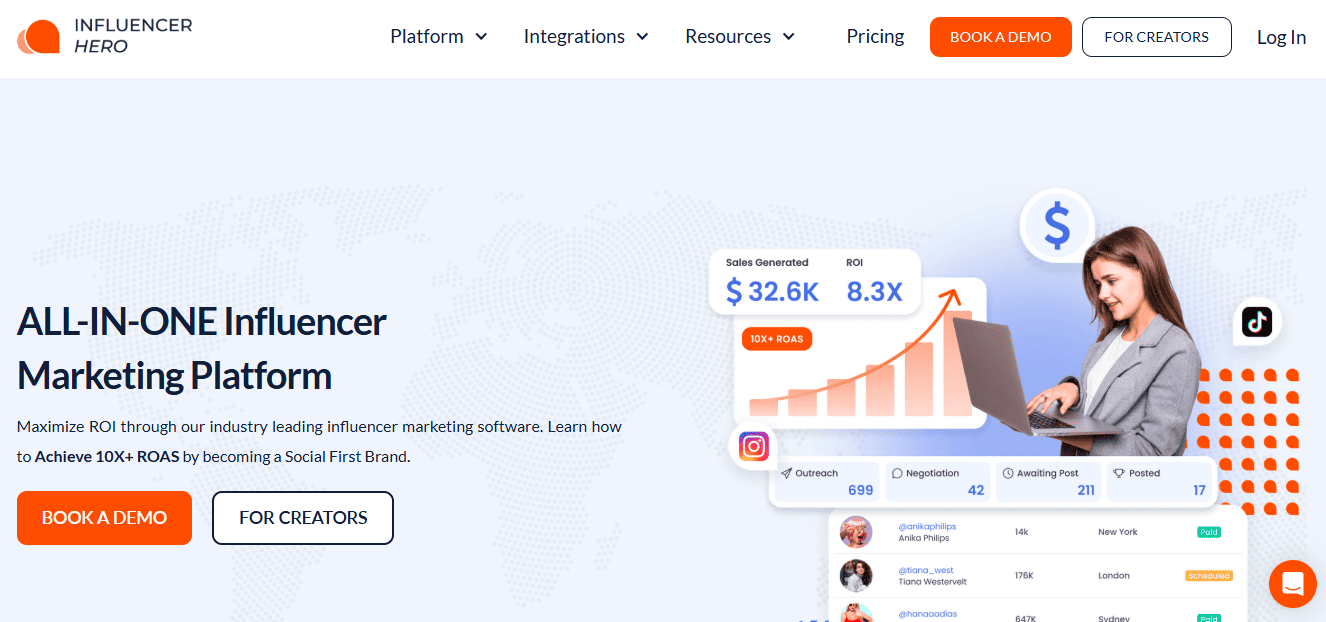
Best For: Growing D2C brands and eCommerce teams (including Shopify and Amazon sellers) looking to scale influencer and affiliate campaigns with automation and deep insights.
Platform Coverage:
Pricing: All plans include core features and can scale as your program grows.
Reviews: 5.0 / 5.0 (Capterra)
Ease of Use (UX/UI): Known for its clean interface and intuitive dashboard, Influencer Hero offers drag-and-drop campaign setups, automated workflows, and customizable email templates. Brands save hours weekly thanks to the streamlined design and AI-driven features.
Customer Support: Influencer Hero’s customer support is a standout feature:
Insense primarily focuses on connecting brands with creators for content generation and paid collaborations, while Influencer Hero provides a fully integrated platform covering influencer discovery, CRM, outreach, UGC management, gifting, affiliate tracking, and storefronts—all in one place.
Pricing is another key differentiator. Insense typically charges per campaign or collaboration, which can quickly add up for brands scaling their influencer efforts. Influencer Hero, on the other hand, offers transparent monthly plans starting at $649, with unlimited campaigns and scalable creator limits—making it far more cost-effective for long-term growth.
Moreover, Influencer Hero’s AI-driven automation, multi-platform coverage, and dedicated 24/7 support with an account manager set it apart as a premium choice for brands serious about scaling influencer programs efficiently and profitably.

Best For: Enterprise-level brands, particularly in beauty, fashion, and lifestyle, that need robust influencer performance benchmarking, ROI tracking, and budget optimization across multiple markets.
Platform Coverage:
Pricing: Pricing is custom-built and tailored, but some users mention that transparency during the scoping phase could be improved.
Reviews: 4.3 / 5.0 (G2)
Ease of Use (UX/UI): Users describe Traackr as having a clean and logical interface with workflows that simplify campaign management once the platform is learned. However, the advanced features require training, resulting in a moderate learning curve.
Customer Support: Traackr is known for exceptional customer success and onboarding, offering responsive support and strategic consulting. Users report that the support team is proactive in helping brands set up and optimize campaigns, making it particularly strong for enterprise clients.
Insense is more focused on UGC generation and campaign flexibility, with a vetted influencer marketplace and strong integrations with TikTok and Meta APIs for verified data. It’s ideal for brands seeking high-quality content and an easy-to-use platform with competitive pricing. Insense offers flexible quarterly billing starting at around $1,500/quarter, making it more accessible for small to medium brands.
On the other hand, Traackr is built for enterprise brands that prioritize performance benchmarking and ROI analytics. Its proprietary tools like Brand Vitality Score and Budget Optimization Calculator make it a go-to solution for data-driven marketing teams with large budgets. However, it comes at a much higher price point, starting at $32,500/year and requiring long-term commitments.
For brands looking for scalable UGC campaigns and lower cost entry, Insense is the better choice. For companies needing deep analytics, global benchmarking, and enterprise-grade support, Traackr is the more powerful—albeit significantly more expensive—option.

Best For: eCommerce brands on Shopify and Amazon that want to scale influencer campaigns while directly tracking sales and ROI from influencer collaborations.
Platform Coverage:
Pricing: Annual contract with quarterly payment options; no commission fees charged
Reviews: 4.3 / 5.0 (G2)
Ease of Use (UX/UI): Users appreciate Upfluence’s all-in-one platform and smooth navigation between influencer search, outreach, and campaign tracking. However, some mention that the setup process can be complex, especially for beginners who need training to fully leverage the platform.
Customer Support: Customer support is reported as responsive and helpful, with onboarding support included. Brands highlight that the support team helps optimize campaigns and integrations, although some note that the annual contract structure limits flexibility.
Insense focuses on UGC generation with its vetted creator marketplace and strong TikTok/Meta API integrations, making it ideal for brands prioritizing high-quality, reusable content. Its pricing is flexible—starting at $500/quarter—and requires no large upfront annual commitment, making it accessible for small to medium-sized brands.
Upfluence, in contrast, is a data-driven, eCommerce-focused platform designed to tie influencer marketing directly to sales. Its integrations with Shopify and Amazon give brands a clear line of sight into ROI, while AI-powered outreach and bulk payments streamline campaigns at scale. However, the high annual cost ($16K+) and mandatory contracts may limit adoption among smaller teams.
For brands seeking affordable, UGC-focused campaigns, Insense is the stronger choice. For eCommerce businesses that need sales attribution and advanced integrations with Shopify and Amazon, Upfluence justifies its premium pricing.

Best For: Large brands and enterprises looking for advanced influencer search, competitive tracking, and deep campaign analytics.
Platform Coverage:
Pricing: Pricing is rigid, with no monthly or flexible plans, and is tailored to enterprise budgets.
Reviews: 4.0 / 5.0 (G2)
Ease of Use (UX/UI): Users praise Captiv8’s comprehensive dashboard and ability to manage campaigns collaboratively, but note that the platform can feel complex for smaller teams. While the analytics and reporting tools are robust, the high learning curve may require extensive onboarding to fully utilize.
Customer Support: Customer support reviews are mixed. While onboarding is reported to be helpful, several users and creators report slow response times, unresolved issues, and difficulties with payment processing. This has led to some dissatisfaction, especially among brands expecting premium service at this price point.
Insense is built for brands that want high-quality UGC with flexible campaign types and competitive pricing. It starts at just $500/quarter and allows brands to scale without committing to expensive annual contracts. Insense’s marketplace of vetted influencers and direct integrations with TikTok and Meta make it a strong choice for brands prioritizing content quality and cost-efficiency.
Captiv8, by contrast, is an enterprise-grade solution with a price tag to match. Starting at $25,000/year, plus onboarding fees and optional $20K+ monthly affiliate features, it’s designed for large brands that require deep analytics, competitor tracking, and team-wide collaboration tools. However, its customer service issues and rigid pricing make it less appealing to smaller businesses.
For brands needing flexible, affordable UGC campaigns, Insense is the better choice. For enterprise teams looking for robust analytics and competitive intelligence, Captiv8 justifies its cost—provided the budget and support expectations align.

Best For: Large brands and agencies managing global influencer programs across multiple markets, seeking end-to-end lifecycle management from discovery to reporting with strong analytics and strategic support.
Platform Coverage:
Pricing: CreatorIQ’s pricing is designed for enterprises, with no monthly flexibility or free trial.
Reviews: 4.5 / 5.0 (G2)
Ease of Use (UX/UI): Users report that CreatorIQ has a streamlined and professional interface that supports complex campaign setups while remaining intuitive. The customizable dashboards and real-time data make it easy to track KPIs, though its extensive features require some onboarding to fully leverage.
Customer Support: CreatorIQ is praised for its excellent customer support, offering dedicated implementation managers and customer success teams. Users benefit from strategic input, onboarding assistance, and quarterly planning, highlighting it as more than just software but a strategic partner.
Insense focuses on UGC-driven campaigns with a self-service model, making it ideal for small to medium brands needing flexible pricing (starting at $500/quarter) and high-quality, vetted content. Its marketplace and TikTok/Meta API integrations make it particularly strong for brands seeking authentic creator-generated content.
CreatorIQ, on the other hand, is built for enterprise-scale influencer marketing. It offers end-to-end lifecycle management, custom reporting, and strong strategic support, making it suitable for global campaigns. However, it requires a large annual investment and lacks flexibility for smaller brands.
For brands prioritizing cost efficiency and UGC, Insense is the clear choice. For enterprises needing robust analytics, advanced CRM features, and a strategic partner, CreatorIQ justifies its premium pricing.

Best For: Brands and agencies that want data-driven influencer marketing with a strong focus on fraud detection, audience authenticity, and competitive analysis.
Platform Coverage:
Pricing: Offers a 24–48 hour free trial to test core functionalities before committing.
Reviews: 4.5 / 5.0 (G2)
Ease of Use (UX/UI): Users appreciate HypeAuditor’s intuitive interface and clean dashboards, highlighting its advanced analytics and fraud detection tools. However, some users mention that fully leveraging all features requires onboarding due to the platform’s complexity.
Customer Support: Customer support is described as helpful and responsive, with onboarding assistance and tutorials available. Some users note that while support is effective, there can be delays in resolving technical issues during high-demand periods.
Insense and HypeAuditor approach influencer marketing with different priorities. Insense focuses on UGC creation and campaign flexibility, offering a vetted marketplace of creators and direct TikTok/Meta API integrations. Its pricing is far more accessible, starting at $500/quarter, and allows brands to scale without a long-term financial commitment. This makes Insense ideal for small to medium-sized brands prioritizing high-quality content at competitive costs.
HypeAuditor, in contrast, is a data-first platform built around fraud detection, audience analysis, and advanced competitive tracking. Its tools are highly valuable for brands where influencer authenticity and ROI attribution are critical. However, its $10K+ annual pricing and complexity make it a better fit for brands with larger budgets and dedicated influencer marketing teams.
For brands seeking affordable UGC campaigns with vetted creators, Insense is the best option. For businesses needing deep data analytics and fraud prevention at scale, HypeAuditor stands out despite its higher cost.

Best For: DTC and eCommerce brands looking for an all-in-one influencer marketing solution that integrates directly with their online store to manage influencer relationships, product seeding, payments, and UGC in a single platform.
Platform Coverage:
Pricing: 12-Month Commitment: Required for all plans
Reviews: 4.5 / 5.0 (G2)
Ease of Use (UX/UI): Users highlight GRIN’s centralized dashboard and all-in-one workflow as a major time-saver, but note that occasional bugs and slow performance can interrupt usability. The UI is intuitive for managing multiple campaigns once users are familiar with the layout.
Customer Support: Customer support is generally helpful, with onboarding and optional strategist support available. However, users report inconsistent follow-through, with some tickets remaining unresolved and long response times during busy periods.
Insense is designed for brands that want affordable, high-quality UGC with a focus on campaign flexibility and vetted creators. Its pricing starts at just $500/quarter, making it accessible for small to medium businesses. The platform excels at generating content efficiently through a marketplace model and provides direct TikTok and Meta API integrations for verified performance data.
GRIN, by contrast, is a premium, enterprise-level solution built for eCommerce brands that need a complete influencer management ecosystem. Its tight Shopify/WooCommerce integration, affiliate tracking, and centralized UGC library make it ideal for brands with high sales volumes and large creator rosters. However, it comes at a steep cost ($25K+/year) and requires a long-term commitment.
For brands looking for scalable UGC campaigns with lower upfront costs, Insense is the clear choice. For large eCommerce teams seeking a feature-rich, fully integrated influencer marketing stack, GRIN provides strong ROI—if the budget allows.
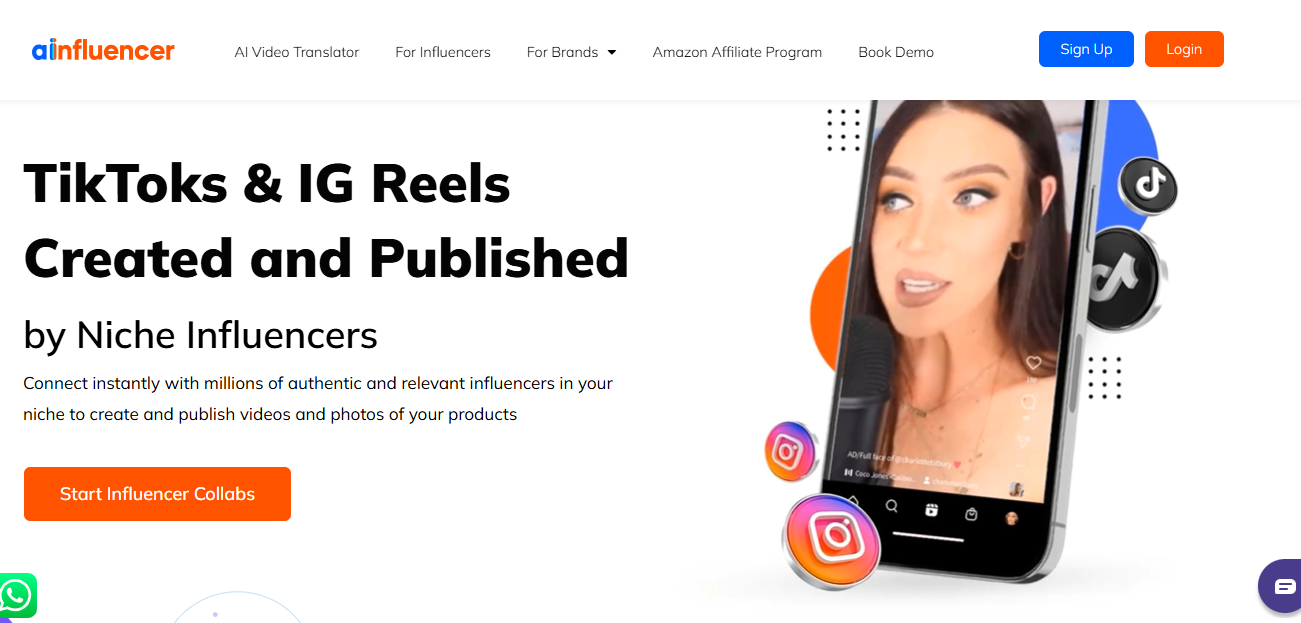
Best For: Small to mid-sized brands seeking cost-effective influencer campaigns with a strong emphasis on escrow-protected payments and direct negotiations with creators through an in-app chat system.
Platform Coverage:
Pricing:
Reviews: 4.4 / 5.0 (G2)
Ease of Use (UX/UI): Users describe AInfluencer’s interface as straightforward and easy to navigate, especially for creating campaigns quickly. However, the analytics and reporting tools are basic, requiring brands to rely on manual checks or influencer-provided screenshots for deeper insights.
Customer Support: Customer support is responsive and available for troubleshooting campaign issues, though some users mention delays during high campaign volumes. Managed campaigns offer dedicated support, while self-service brands mostly rely on email and chat.
Insense offers a vetted marketplace with high-quality UGC, verified data from Meta and TikTok APIs, and flexible campaign types (UGC, whitelisting, TikTok Shop, affiliate). It starts at just $500/quarter, making it an affordable yet powerful option for brands wanting quality content with verified performance metrics.
AInfluencer, on the other hand, focuses on cost-free entry for self-service users and provides an escrow payment system to ensure safe transactions. While it has a large influencer marketplace, it lacks advanced analytics, affiliate tracking, and deep reporting—features that brands scaling campaigns often need. Managed campaign packages are also significantly more expensive.
For brands that prioritize content quality, verified insights, and flexible campaign scaling, Insense offers better value. AInfluencer is ideal for brands starting out or those seeking budget-friendly influencer collaborations without the need for advanced analytics.
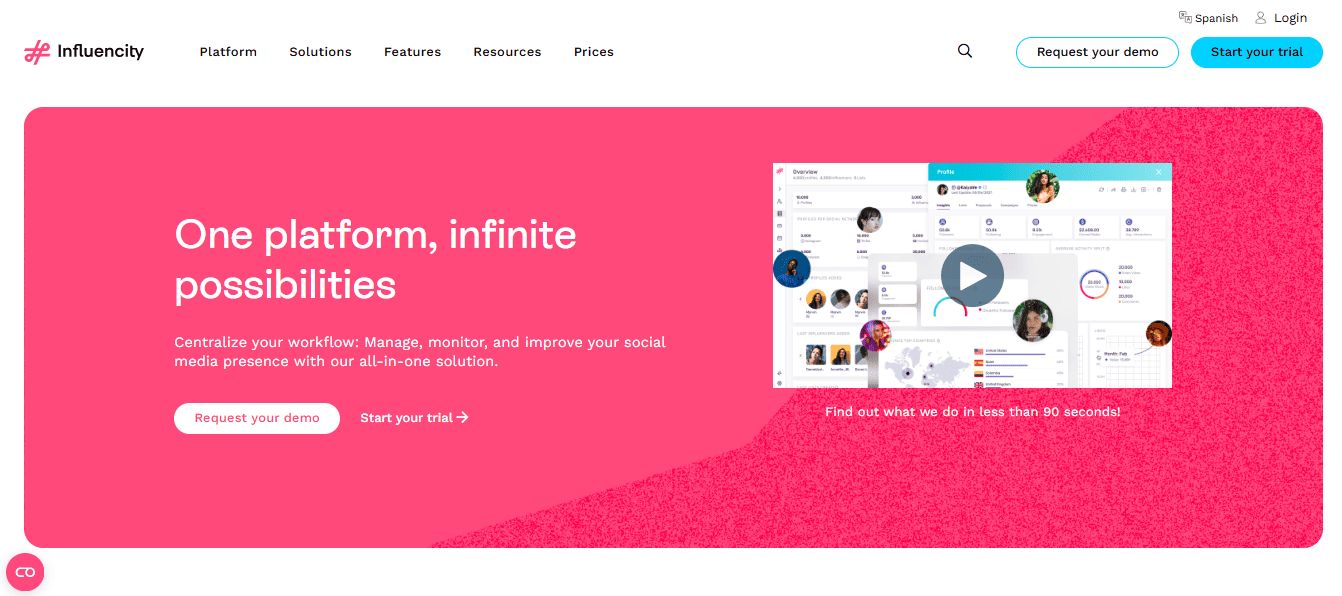
Best For: Brands and agencies that need a cost-efficient yet comprehensive influencer marketing tool with strong discovery, CRM, and reporting features, particularly those managing multiple campaigns across regions.
Platform Coverage:
Pricing: Influencity offers different plans:
Reviews: 4.5 / 5.0 (G2)
Ease of Use (UX/UI): Users highlight the visual CRM and campaign boards that resemble Trello, making project management easy. However, the 4–6 week onboarding and reliance on external email tools for negotiations can slow down early adoption.
Customer Support: Customer support is described as helpful during onboarding, but some users report slow responses when resolving technical issues. Dedicated support is stronger in the Business Plan, where an AI-powered email assistant is also available.
Insense is focused on UGC quality with a vetted creator marketplace and verified API data from Meta and TikTok. It offers flexible campaign types and affordable pricing starting at $500/quarter, making it highly attractive for small to medium brands prioritizing content quality and verified performance.
Influencity, by comparison, provides a broader discovery database (15M+ public profiles) and a comprehensive CRM/reporting system at an affordable annual price of $3,816. However, it lacks native UGC licensing, in-platform negotiation, and advanced outreach automation, requiring external tools for full functionality. It is best suited for brands wanting large-scale influencer discovery with strong segmentation and reporting capabilities.
For brands that value UGC quality and campaign flexibility, Insense is the stronger option. For those needing a large searchable database, organized campaign boards, and cost-effective analytics, Influencity offers excellent value.

Best For: Brands looking for a data-driven influencer marketing platform with AI-powered discovery, robust analytics, and an integrated CRM, especially those managing campaigns across both B2C and B2B networks.
Platform Coverage:
Pricing: All plans include AI-powered influencer discovery, CRM features, outreach tools, and access to the Chrome extension, with higher plans adding advanced analytics, unlimited campaigns, and white-labeling.
Reviews: 4.6 / 5.0 (G2)
Ease of Use (UX/UI): Users praise Favikon for its streamlined dashboard, AI-driven insights, and easy-to-navigate interface. However, smaller brands may find the extensive data and custom scoring system initially overwhelming without training.
Customer Support: Favikon offers 24/7 chatbot support for all users, with personalized onboarding for Standard and Pro plans. While support is efficient, some users note that direct human assistance is limited in lower-tier plans.
Insense focuses on UGC creation, offering vetted influencers, verified API data (Meta, TikTok), and flexible campaign types. Its pricing starts at $500/quarter, making it ideal for small to medium brands prioritizing content quality and ease of use.
Favikon, on the other hand, is a data-heavy platform with AI-powered rankings, multi-platform coverage (including LinkedIn), and a low-cost entry starting at $69/year. It is best suited for brands wanting in-depth analytics and discovery tools without needing advanced UGC or affiliate automation. However, brands must handle UGC rights, product gifting, and affiliate payments externally, which may limit campaign scalability.
For brands seeking high-quality UGC with flexible scaling and built-in campaign workflows, Insense is the better choice. For teams prioritizing AI-driven influencer analytics and cost-efficient discovery, Favikon offers strong value at an unbeatable price point.
Choosing the right influencer marketing platform can make or break your campaign success in 2025. While Insense remains a strong choice for brands focused on generating UGC with vetted creators, its limitations such as basic analytics, narrow platform coverage, and rigid pricing, often lead marketers to explore other options.
Among these options, Influencer Hero clearly stands out as the best Insense alternative. Unlike Insense, it provides a true all-in-one solution with advanced influencer discovery, AI-powered outreach, built-in affiliate payments, customizable storefronts, and multi-platform coverage. Book a demo with Influencer Hero to see how it can scale your influencer marketing in a smarter way!

The best alternative to Insense is Influencer Hero, as it offers a complete all-in-one solution that goes beyond UGC sourcing. It includes influencer discovery, AI-powered outreach, CRM, analytics, gifting, affiliate tracking, and customizable creator storefronts—all in one platform. Unlike Insense, which mainly focuses on TikTok and Instagram campaigns, Influencer Hero supports multiple platforms and provides unlimited campaign management under transparent pricing.
You may consider an Insense alternative if you need advanced reporting, multi-platform coverage, and more flexible campaign tools. While Insense is great for UGC, it lacks comprehensive analytics and features like affiliate payments or storefronts. Alternatives like Influencer Hero, Traackr, and CreatorIQ offer broader capabilities, including end-to-end campaign tracking and better scalability for growing brands.
For SMBs, Influencer Hero is the top choice because it combines powerful automation and multi-platform support with pricing that scales to fit smaller budgets. Other good options include Favikon, which offers affordable annual plans with AI-powered influencer scoring, and AInfluencer, which provides a free self-service model for brands starting with influencer marketing.
Yes, several alternatives provide deeper insights and ROI tracking compared to Insense. Influencer Hero offers real-time analytics, automated dashboards, and affiliate performance tracking across campaigns. Platforms like CreatorIQ and Traackr also excel in advanced reporting, but they are more suited to enterprise brands due to their high cost.
Influencer Hero is one of the few platforms that fully supports both UGC creation and affiliate campaign management. It allows brands to source user-generated content, manage influencer relationships, track affiliate sales, and even provide creators with customizable storefronts—all in one place. Other platforms like Grin and Upfluence also offer affiliate tracking, but they require larger budgets and long-term contracts.



Schedule a Demo with one of our media experts below.